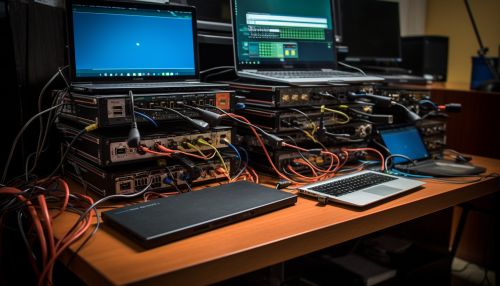Computer network
Overview
A computer network is a digital telecommunications network which allows nodes to share resources. In computer networks, computing devices exchange data with each other using connections (data links) between nodes. These data links are established over cable media such as twisted pair or fiber-optic cables, and wireless media such as Wi-Fi. Network computer devices that originate, route and terminate the data are called network nodes. Nodes are generally identified by network addresses, and can include hosts such as personal computers, phones, and servers, as well as networking hardware such as routers and switches.
History
The history of computer networks dates back to the early 1960s, when the U.S. Department of Defense led the creation of the Advanced Research Projects Agency Network (ARPANET), the precursor to the Internet. The concept of packet switching, which is a method of grouping data that is transmitted over a digital network into packets, was introduced by Paul Baran in the early 1960s. This led to the development of the packet-switched network of ARPANET, which later evolved into the modern Internet.
Types of Networks
Computer networks can be categorized in several different ways. One approach defines the type of network according to the geographic area it spans. Local area networks (LANs), for example, typically span a single home, school, or small office building, whereas wide area networks (WANs), reach across cities, states, or even across the world. The Internet is the world's largest public WAN.
Local Area Network (LAN)
A Local Area Network (LAN) is a network that is confined to a relatively small area. It is generally limited to a geographic area such as a writing lab, school, or building. Rarely are LAN computers more than a mile apart. In a typical LAN configuration, one computer is designated as the file server. It stores all of the software that controls the network, as well as the software that can be shared by the computers attached to the network.


Wide Area Network (WAN)
A Wide Area Network (WAN) spans a large geographic area, often a country or continent. It contains a collection of machines intended for running user (i.e., application) programs. These machines, called hosts, are connected by a communication subnet, or just subnet for short. The hosts are owned by the customers (e.g., people's personal computers), and the subnet is typically owned and operated by a network provider (e.g., the phone company).
Metropolitan Area Network (MAN)
A Metropolitan Area Network (MAN) is a network that connects two or more local area networks or campus area networks together but does not extend beyond the boundaries of the immediate town, city, or metropolitan area. Multiple routers, switches, and hubs are connected to create a MAN.
Network Architecture
Network architecture is the design of a communication network. It is a framework for the specification of a network's physical components and their functional organization and configuration, its operational principles and procedures, as well as data formats used in its operation.
OSI Model
The Open Systems Interconnection model (OSI model) is a conceptual model that characterizes and standardizes the communication functions of a telecommunication or computing system without regard to its underlying internal structure and technology. Its goal is the interoperability of diverse communication systems with standard communication protocols.
TCP/IP Model
The Internet protocol suite (TCP/IP model) is the conceptual model and set of communications protocols used in the Internet and similar computer networks. It is commonly known as TCP/IP because the foundational protocols in the suite are the Transmission Control Protocol (TCP) and the Internet Protocol (IP).
Network Protocols
A network protocol defines rules and conventions for communication between network devices. Protocols for computer networking all generally use packet switching techniques to send and receive messages in the form of packets.
Internet Protocol (IP)
The Internet Protocol (IP) is the principal communications protocol in the Internet protocol suite for relaying datagrams across network boundaries. Its routing function enables internetworking, and essentially establishes the Internet.
Transmission Control Protocol (TCP)
The Transmission Control Protocol (TCP) is one of the main protocols in the Internet protocol suite. It originated in the initial network implementation in which it complemented the Internet Protocol (IP). Therefore, the entire suite is commonly referred to as TCP/IP.
User Datagram Protocol (UDP)
The User Datagram Protocol (UDP) is one of the core members of the Internet protocol suite. With UDP, computer applications can send messages, in this case referred to as datagrams, to other hosts on an Internet Protocol (IP) network.
